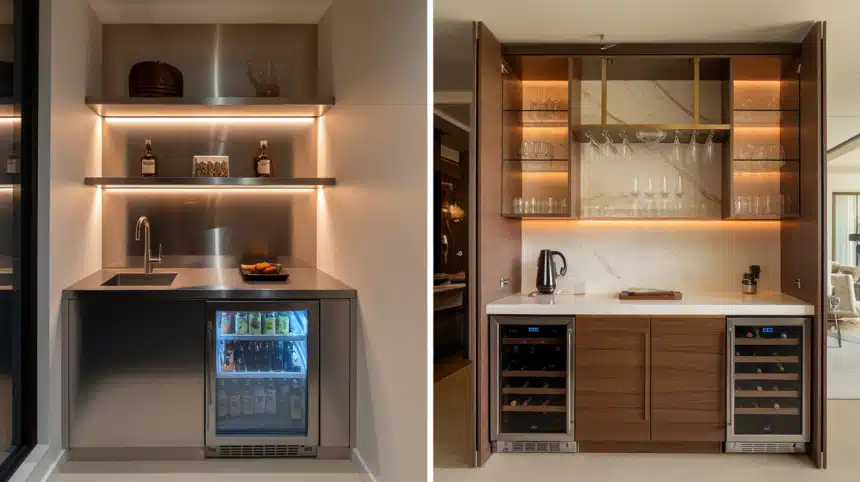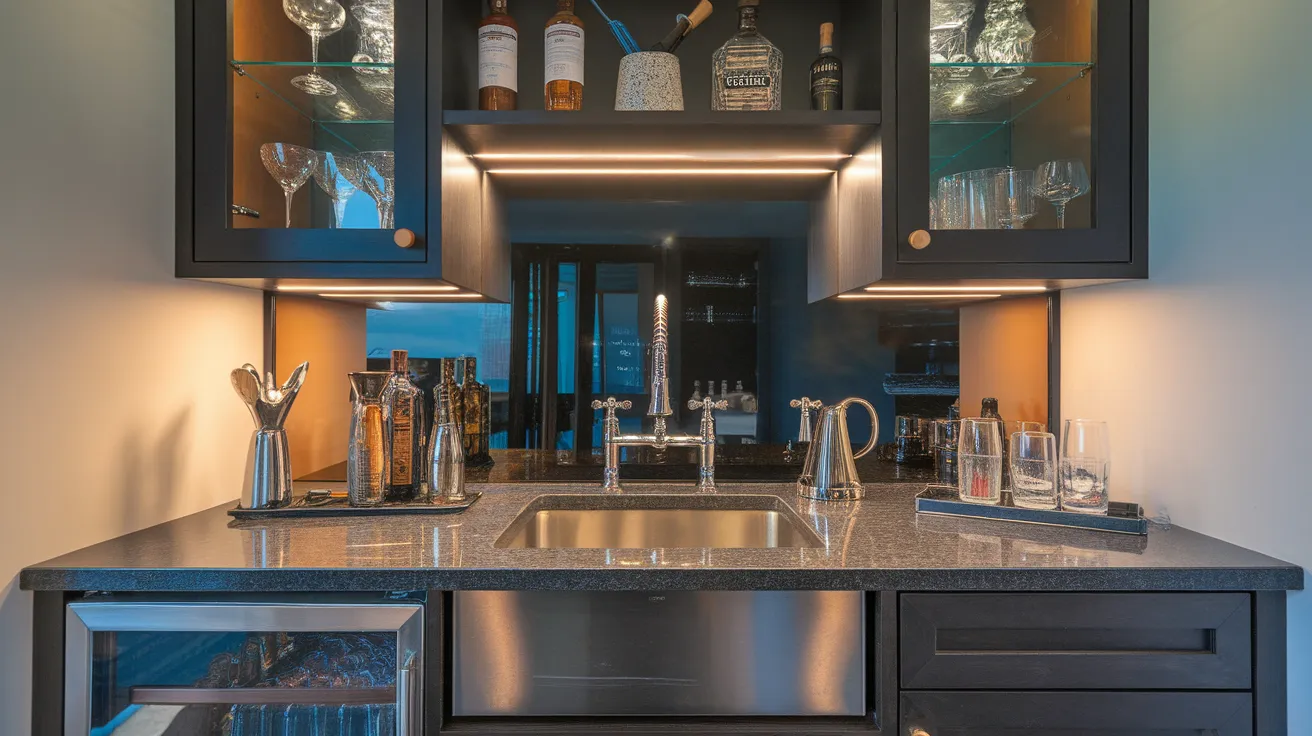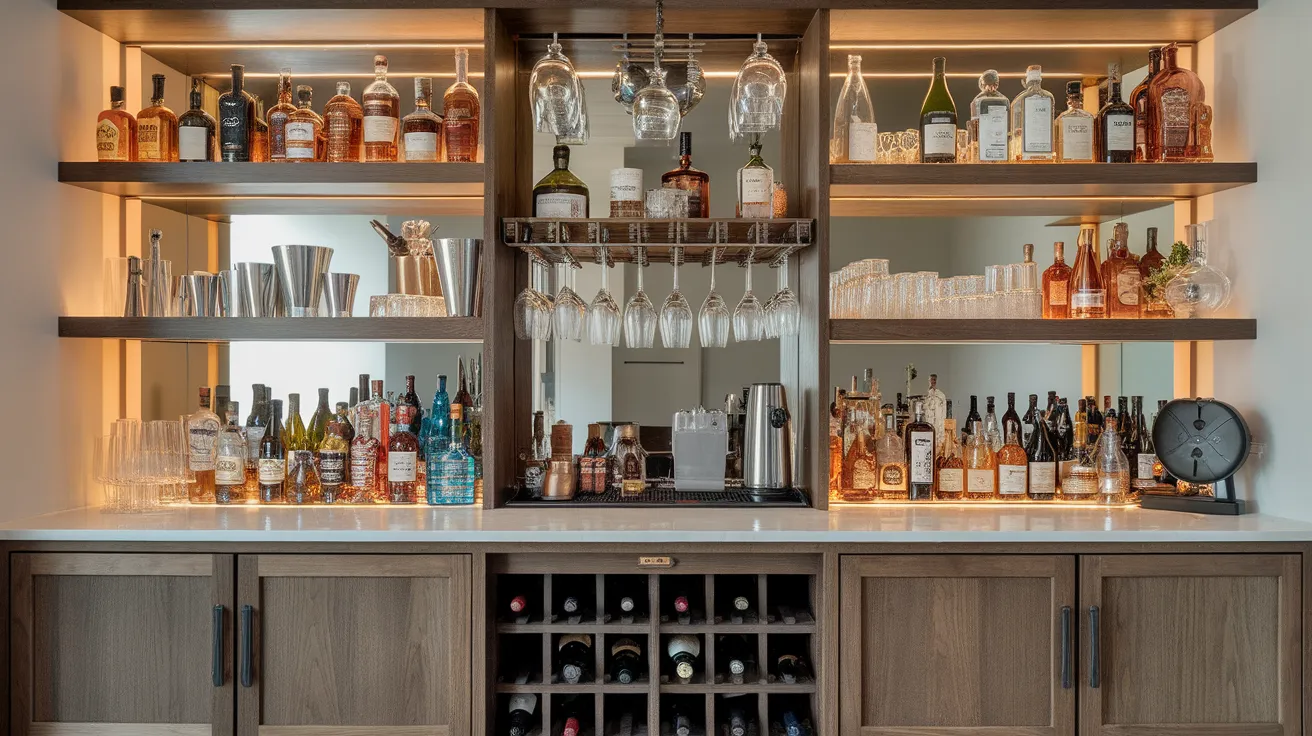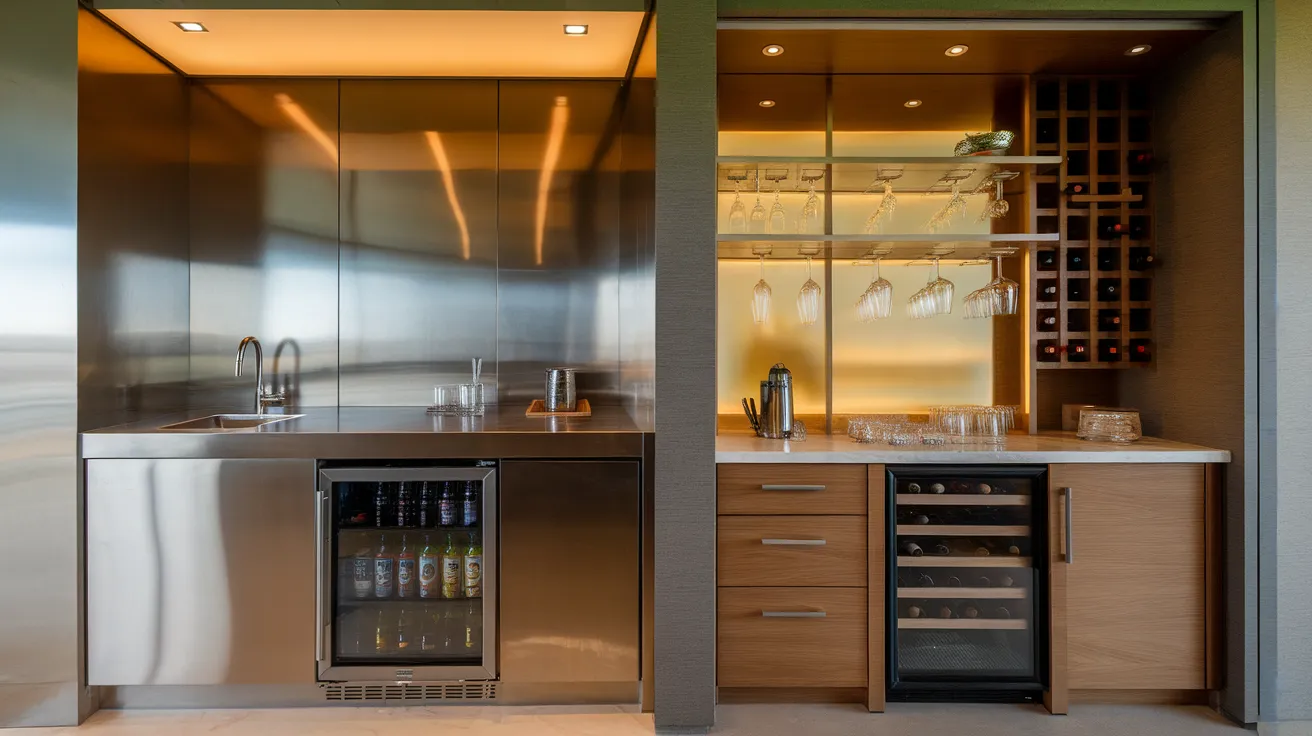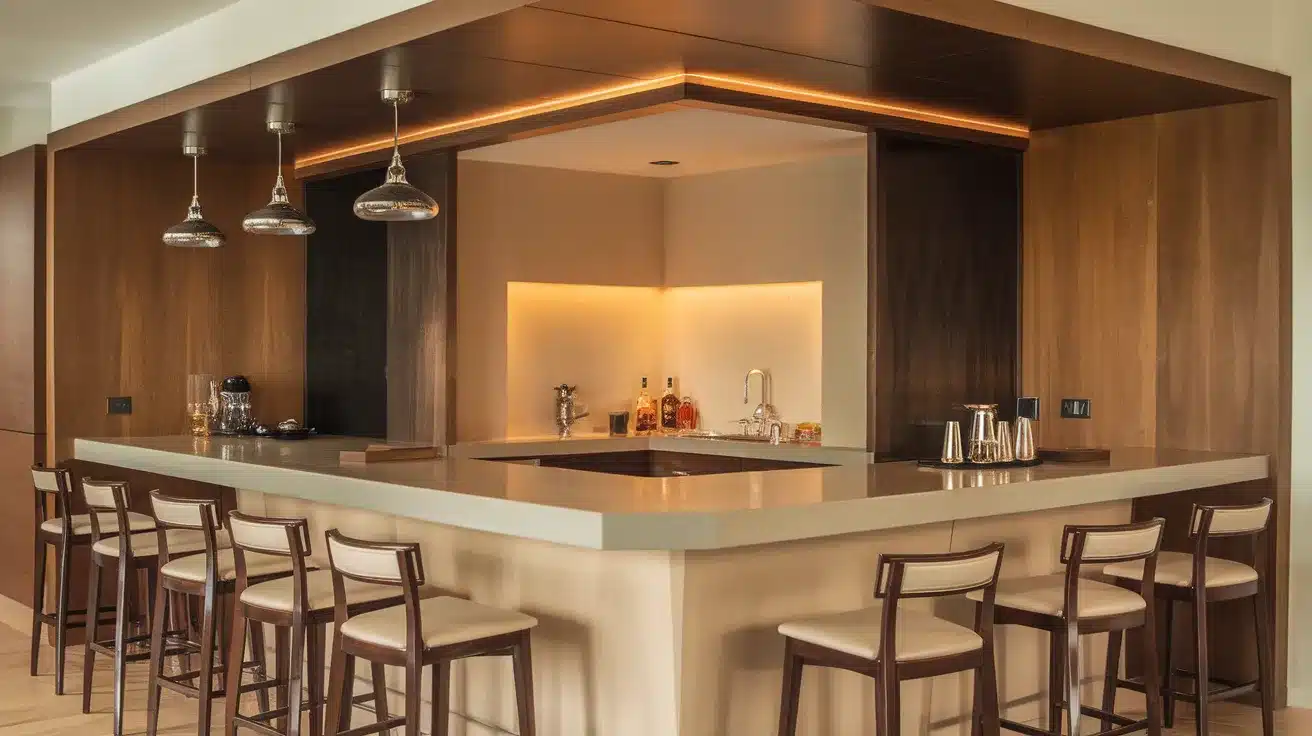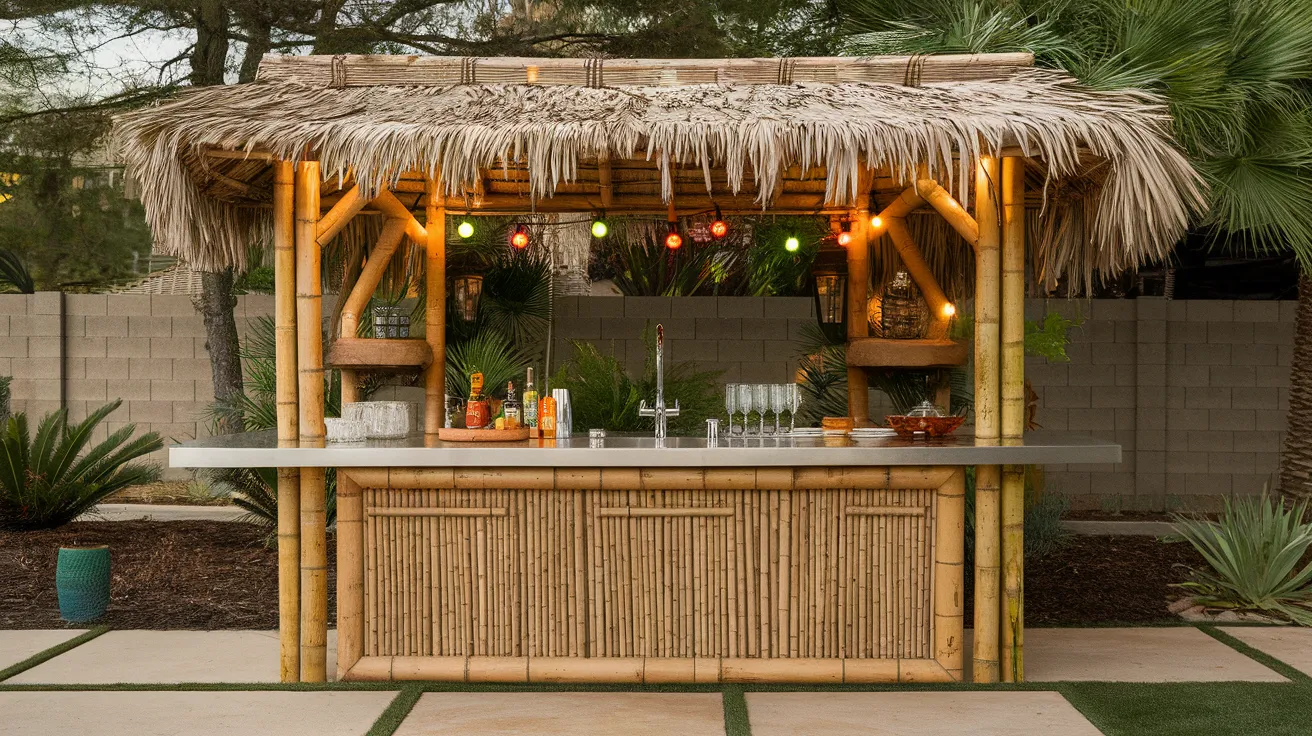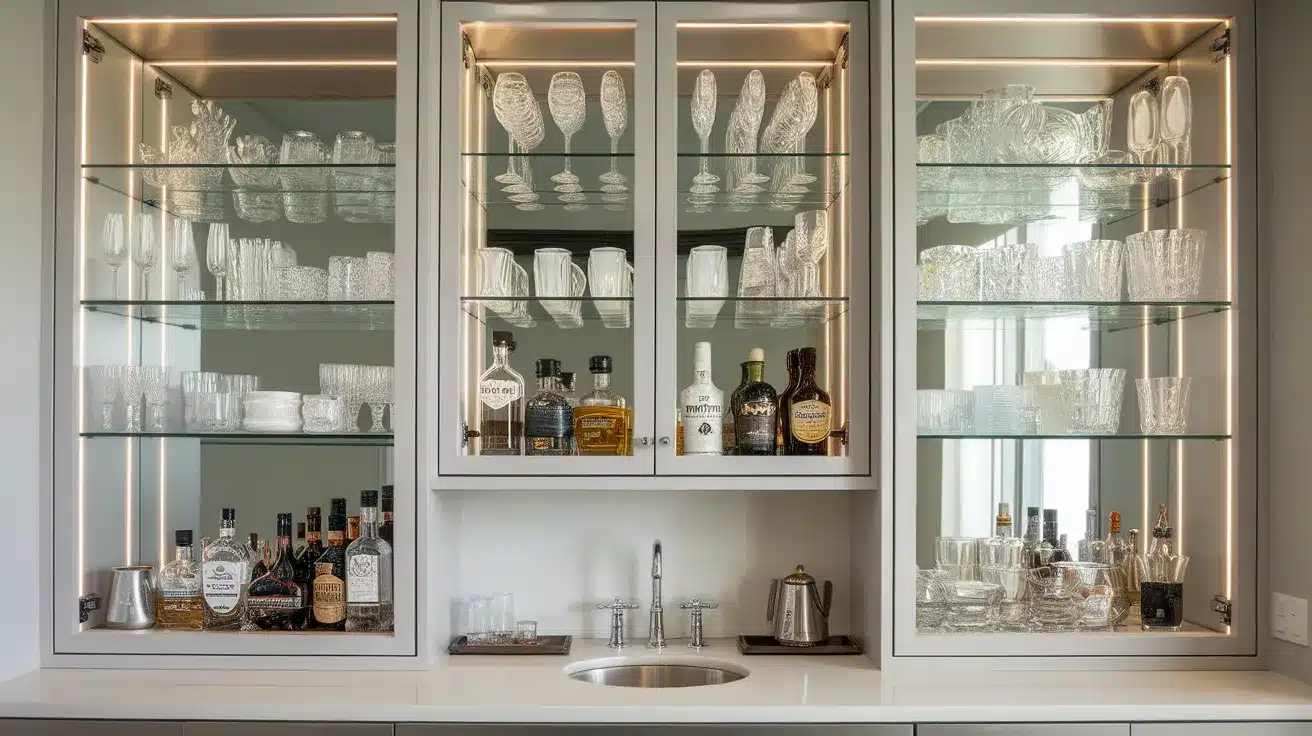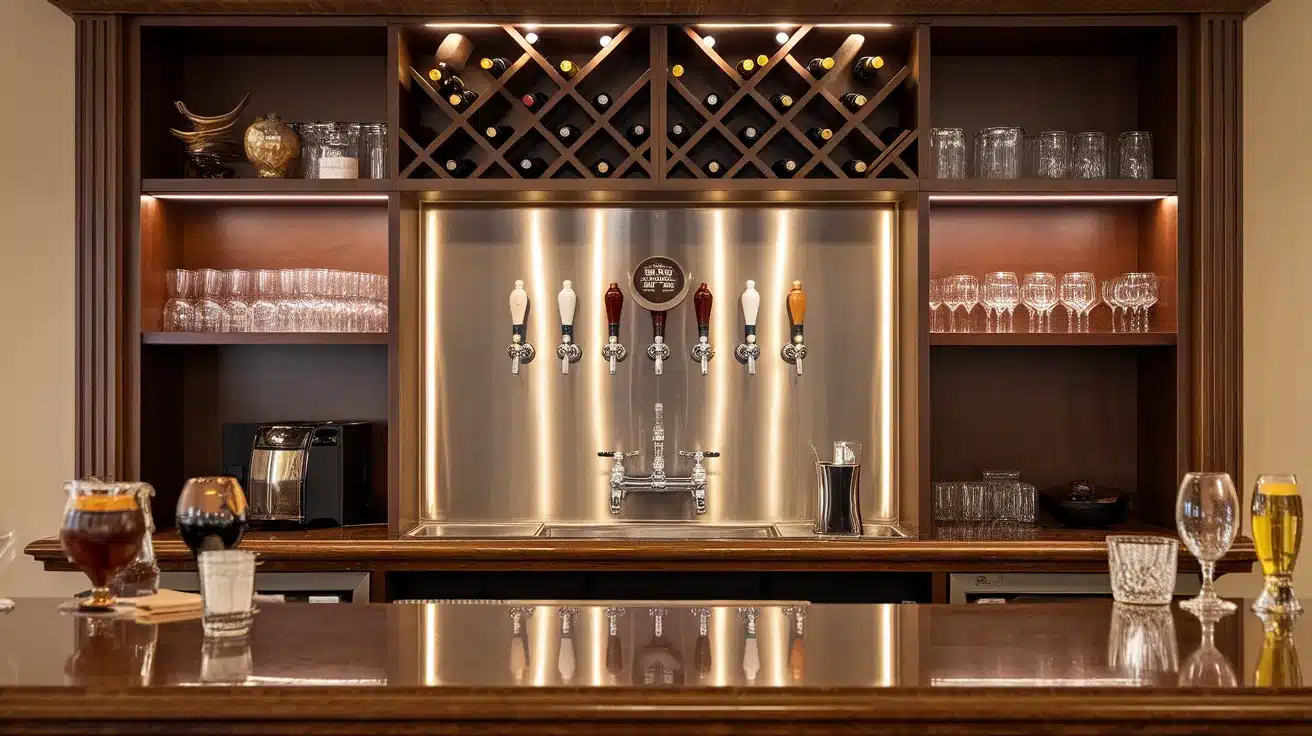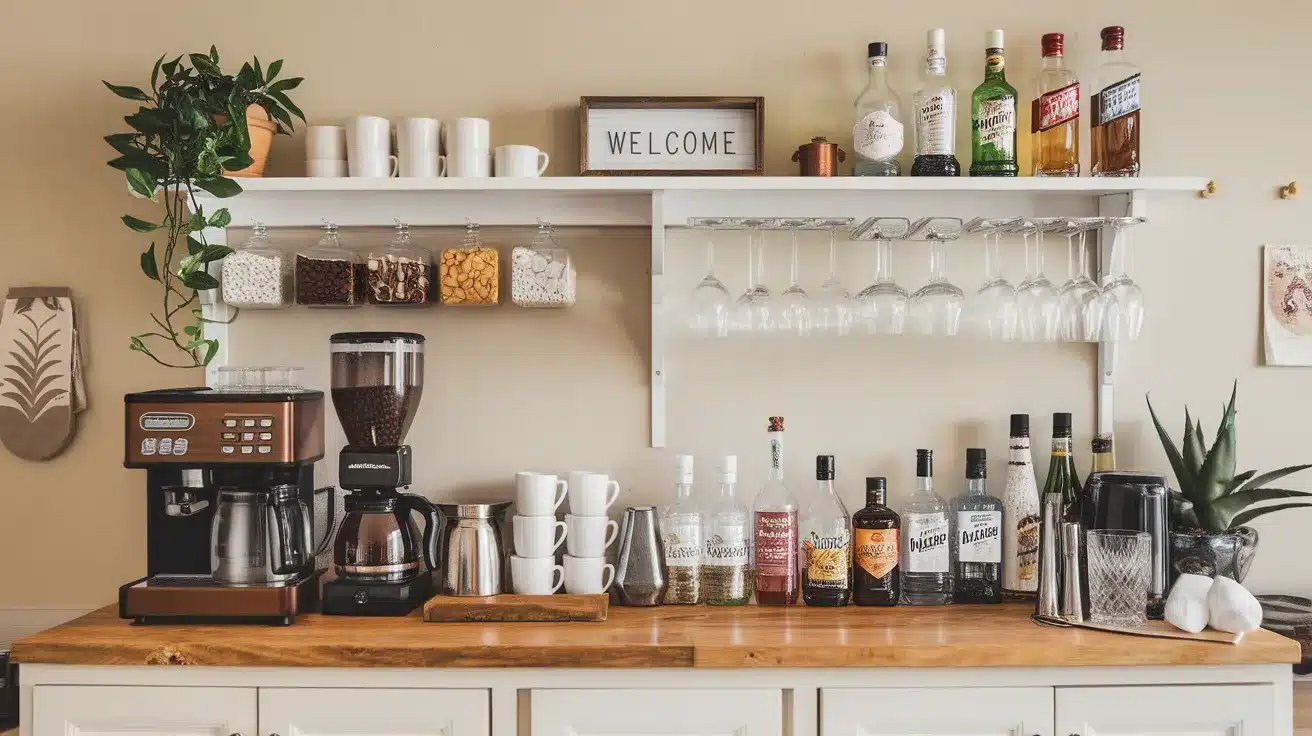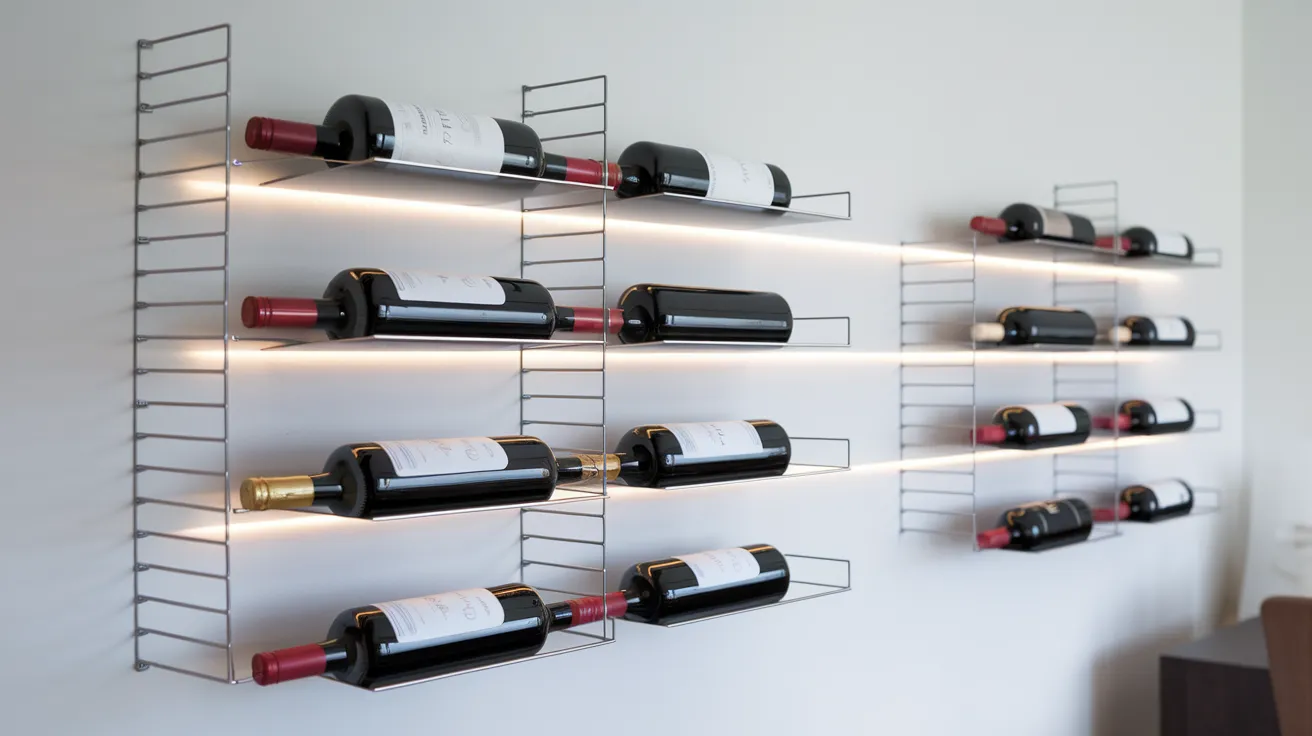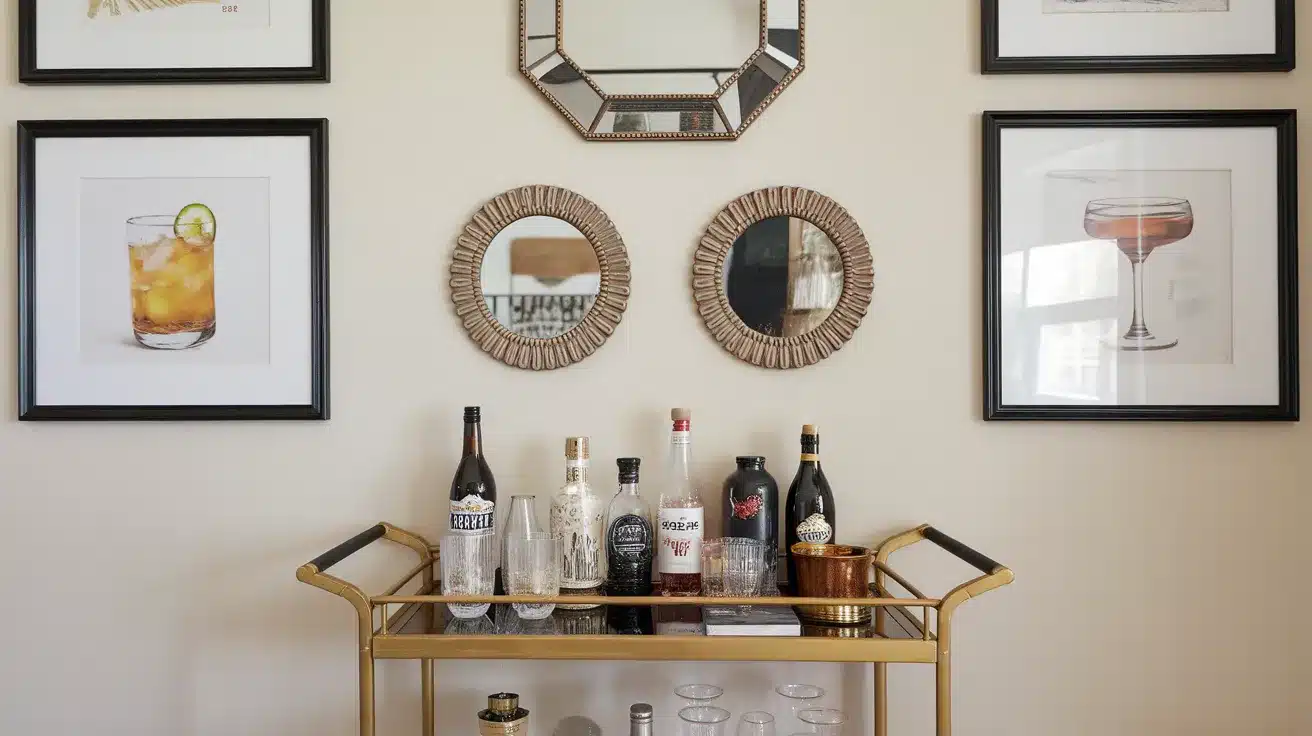Want to add a bar to your home? You’re not alone. Home bars offer comfort and style for both everyday use and guest entertainment.
The choice between wet and dry bars affects how you’ll serve drinks, the cost, and the space needed. A wrong choice might leave you with limited options or unnecessary expenses.
The good news? Both options can work well when planned right. The key is knowing which fits your needs and home setup.
This guide walks you through everything about wet bars and dry bars. You’ll learn the differences, benefits, costs, and practical tips for each type.
Read on to find the perfect home bar solution that matches your budget, space, and entertainment style.
Understanding Home Bar Options: The Basics You Need to Know
Before choosing between bar types, it helps to understand what makes each option unique. Home bars come in different forms, from simple cabinets to built-in stations with all the extras. Your ideal setup depends on several factors:
- Purpose: Will you use it mostly for yourself or for entertaining?
- Frequency: How often will you actually use the bar?
- Drinks: Do you need space for cocktail mixing or just bottle storage?
The main choice most homeowners face is between wet and dry bars. This decision affects everything from installation to how you’ll use the space.
Wet bars include plumbing for water access, while dry bars focus on storage and serving without water connections. The right choice depends on your specific needs, space limitations, and budget considerations.
What is a Wet Bar?
A wet bar is a home drink station that includes a sink with running water. This water feature sets it apart from other bar types. The sink lets you wash glasses, mix drinks, and clean up without trips to the kitchen.
Wet bars need plumbing connections, making them more complex but also more useful for regular hosts. They typically feature a small basin sink and faucet specifically designed for bar use, which takes up less space than a full kitchen sink.
Most wet bars include counter space for drink preparation, cabinets for storing glasses and bottles, and often a small refrigerator for keeping ingredients cold.
Some more advanced wet bars might also include an ice maker, glass rinser, or even a dishwasher for quick cleanup. The plumbing system usually connects to the home’s main water lines and drainage.
Common Locations
- Basement Bars: Makes use of basement space for entertainment. The lower level offers more room for a complete setup and keeps noise away from main living areas.
- Entertainment Rooms: Adds function to media rooms and game areas. Placing a wet bar here means guests can enjoy drinks without missing the movie or game..
- Outdoor Spaces: Brings drink-making convenience to patios and pool areas. Outdoor wet bars often include weather-resistant materials and may need special plumbing considerations.
Ideal For
A wet bar works best for homeowners who:
- Host parties and gatherings often
- Enjoy making mixed drinks and cocktails that require fresh ingredients
- Have homes with extra space for entertainment
- Want to keep guests out of the main kitchen
- Prefer not to carry dirty glasses back and forth
- Plan to serve a wide variety of beverages that need preparation
- Value the look and function of a complete bar setup
Pros and Cons
| Pros | Cons |
|---|---|
| Convenient clean-up after use | Higher costs for installation |
| Complete setup for drink making | Requires plumbing connections |
| Adds value to your home | Possible water damage risks |
| Reduces traffic in main kitchen | Takes up more space |
| Allows for proper glass washing | Needs regular maintenance |
| Supports more complex drink recipes | Permanent fixture that’s hard to move |
| Offers a true bar experience | May need permits for installation |
What is a Dry Bar?
A dry bar is a dedicated drink station without plumbing or running water. It focuses on storage and serving rather than preparation and cleanup. Dry bars offer a simpler solution for home entertaining with less commitment than their wet counterparts.
Without the need for water lines, these bars can fit almost anywhere in your home and often cost much less to install. Dry bars range from simple cabinets with countertops to more structured units with built-in storage.
They provide space for bottles, glassware, and basic bar tools without the complexity of plumbing work. Many homeowners choose dry bars as their first step into home entertaining spaces.
Common Locations
- Living Rooms: Creates an entertaining spot in your main social area without major construction.
- Dining Areas: Offers drink service close to meal spaces for easy pairing and serving.
- Kitchens: Uses existing counter space and cabinetry for an integrated bar feel.
- Apartments: Provides bar functionality in smaller spaces or rental units where plumbing changes aren’t allowed.
Ideal For
A dry bar suits homeowners who:
- Entertain occasionally rather than frequently
- Prefer serving wine and ready-to-drink beverages
- Have limited space in their homes
- Want to keep costs down
- Might move the bar setup in the future
- Rent their living space
- Need a simpler, low-maintenance option
- Like to update their home decor periodically
Pros and Cons
| Pros | Cons |
|---|---|
| More budget-friendly option | No water access for cleanup |
| Simple installation process | Less convenient for mixed drinks |
| Can be placed almost anywhere | Requires trips to kitchen for ice/water |
| Often portable or movable | May feel incomplete to serious hosts |
| No risk of plumbing issues | Limited preparation capabilities |
| Works in rental properties | Glass washing must happen elsewhere |
| Easier to change or update | Less impressive to guests |
| Minimal construction needed | Storage is often more limited |
Wet Bar vs. Dry Bar: Key Differences
When planning a home bar, understanding the differences between wet and dry options helps you make the right choice. These two bar types serve the same basic purpose – creating a space for drinks and entertainment – but with different features and requirements.
The main difference lies in the plumbing. Wet bars include water access through a sink, while dry bars focus only on storage and serving. This key distinction affects everything from cost and installation to how you’ll use the space for guests.
Your choice should match your entertaining style, home setup, and budget. The chart below breaks down the major differences to consider before deciding.
| Feature | Wet Bar | Dry Bar |
|---|---|---|
| Plumbing Requirements | Needs water supply and drain lines; may require professional installation; often needs permits | No plumbing needed, self-installation possible, typically no permits required |
| Cost Comparison | $2,000-$10,000+ depending on features; higher labor costs; plumbing expenses | $500-$3,000 for most setups, lower installation costs, no plumbing expenses |
| Space and Design Considerations | Requires more dedicated space, permanent fixture, needs planning for water lines | More flexible placement, can use existing furniture, and fits in smaller spaces |
| Functionality for Entertaining | Full drink-making capabilities, easier cleanup, supports complex cocktails | Limited to serving drinks; cleanup happens elsewhere, best for simple drinks |
| Maintenance and Upkeep | Regular plumbing maintenance, potential for leaks or water damage, and more cleaning surfaces | Minimal maintenance, no plumbing issues, simpler to clean and maintain |
Factors to Consider When Choosing

The choice between a wet bar and a dry bar affects how you’ll entertain for years to come. Before making your decision, think about these five key factors that will help match your bar to your specific needs and home situation.
1. Your Entertainment Style
How often you host and what types of gatherings you plan will guide your choice. Consider your typical events:
- For frequent hosts: If you have guests over weekly or monthly, a wet bar’s convenience may justify the extra cost.
- For occasional gatherings: Those who entertain a few times yearly might find a dry bar perfectly adequate.
- For cocktail fans: If you enjoy making mixed drinks, a wet bar with running water makes preparation easier.
- For wine and beer servers: If you mainly serve bottled drinks, a dry bar with good storage works well.
2. Budget Constraints
Your budget often becomes the deciding factor when choosing between bar types:
- Initial installation: Wet bars cost significantly more due to plumbing work, typically 2-3 times the price of a dry bar.
- Ongoing expenses: Wet bars may increase water bills slightly and require plumbing maintenance.
- Return on investment: Wet bars often add more home value, but this varies by location and housing market.
- Phased approach: Some homeowners start with a dry bar and upgrade to a wet bar later when finances allow.
3. Available Space
The physical space in your home plays a major role in what’s possible:
- Size requirements: Wet bars typically need more square footage to accommodate plumbing.
- Location flexibility: Dry bars can go almost anywhere, while wet bars need access to water lines.
- Room purpose: Consider how the bar fits with the room’s other functions and traffic flow.
- Storage needs: Assess how much storage you need for glasses, bottles, and accessories.
4. Home Aesthetic
Your bar should complement your home’s style:
- Design cohesion: Choose materials and finishes that match your existing decor.
- Visual impact: Decide whether you want the bar as a focal point or a subtle addition.
- Custom vs. pre-made: Custom bars offer perfect style matching but at higher costs.
- Furniture integration: Dry bars can often blend with other furniture pieces for a cohesive look.
5. Long-Term Plans
Think about the future when making your decision:
- Home value: Well-designed wet bars often add value in higher-end homes.
- Lifestyle changes: Consider how your entertaining habits might change over time.
- Housing market: Research what buyers in your area value if you plan to sell eventually.
- Flexibility needs: Dry bars offer more adaptability if your needs or space might change.
Creative Ideas for Wet Bars
The right design can turn your home bar from functional to fantastic. Here are some creative ways to make your wet bar stand out, whether you’re looking for a statement piece or a practical addition to your home.
1. Multi-level Cocktail Station
A bar with varying counter heights creates visual interest and practical workspace. The lower level works for seating and casual conversation, while the higher counter gives you space for mixing drinks. Add a small sink in the corner for washing tools without disrupting the flow. This setup helps separate the bartender area from the guest space.
2. Outdoor Tiki Bar
Take your wet bar outside with a weather-resistant tiki setup. Use treated woods or composite materials that stand up to the elements, and install a sink with proper drainage. Complete the look with bamboo accents, string lights, and tropical decor. This creates a vacation vibe right in your backyard for summer parties.
3. Glass-front Cabinet Showcase
Install glass-front cabinets above your wet bar sink to display special glassware and bottles. Light the cabinets from within to make your collection glow. This adds both storage and visual appeal. The glass fronts keep dust away while still showing off your best pieces and adding light to the bar area.
4. Built-in Wine and Beer Taps
Add a wine preservation system or beer taps to your wet bar for fresh pours every time. The sink nearby makes cleaning the lines easy and keeps your system working well. This setup brings the full pub experience home and works well for those who enjoy variety without opening full bottles.
Creative Ideas for Dry Bar
The right design can turn your home bar from functional to fantastic. Here are some creative ways to make your dry bar stand out.
1. Coffee and Cocktail Hybrid Station
Create a morning-to-evening bar that works for coffee and cocktails. Include a coffee maker, bean storage, and mugs on one side, with glasses and spirits on the other. This dual-purpose station makes the most of limited space and ensures your bar area stays useful throughout the day.
2. Sleek Floating Wine Wall
Mount slim shelving directly to your wall for a modern wine display that takes up zero floor space. Add small LED lights to highlight the bottles and create mood lighting. This works well in dining rooms or small apartments where floor space is limited but walls are available.
3. Hidden Cabinet Mini-Bar
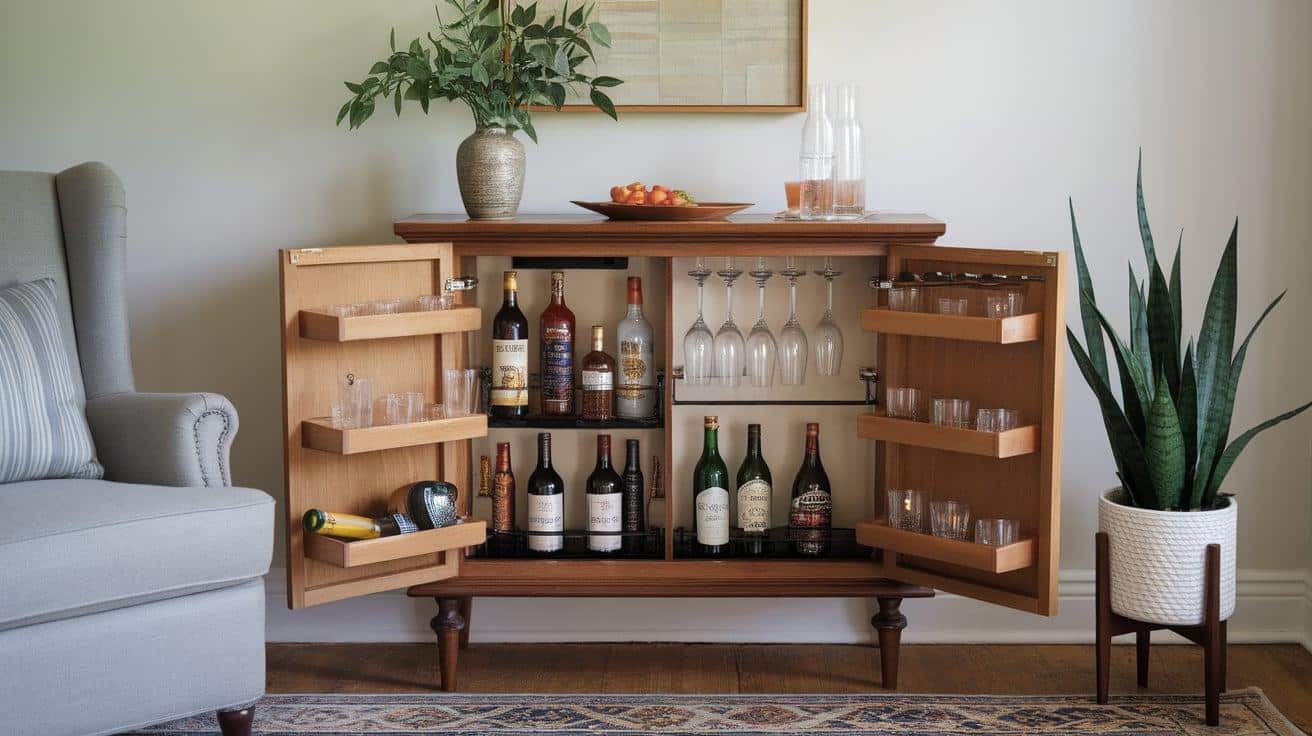
Transform an ordinary cabinet into a pull-out bar complete with bottle storage and a serving surface. When closed, it looks like normal furniture, but opens to reveal everything you need for drinks. This option works well for those who want bar function without dedicating permanent space to it.
4. Bar Cart Gallery Wall
Place a stylish bar cart against a wall decorated with drink-themed art or mirrors. The wall decor draws the eye up, making the small cart feel like part of a larger design statement. This setup can move when needed and works well for renters who can’t make permanent changes.
Which Bar Type Fits Your Life? A Simple Quiz
Not sure whether a wet bar or dry bar is right for you? This quick quiz can help point you in the right direction based on your specific needs and situation.
Question 1: How Often Do You Entertain Guests?
A) Almost every weekend
B) Once or twice a month
C) A few times a year
D) Rarely, but I’d like a bar for my own use
Question 2: What’s Your Budget for This Project?
A) Under $1,000
B) $1,000-$3,000
C) $3,000-$7,000
D) Over $7,000
Question 3: What Types of Drinks Do You Typically Serve?
A) Mostly wine and beer
B) Simple mixed drinks
C) Complex cocktails requiring fresh ingredients
D) A wide variety of everything
Question 4: How Much Space Can You Dedicate to Your Bar?
A) Just a corner or small wall
B) About the size of a large bookcase
C) A dedicated section of a room
D) An entire room or area
Question 5: Do You Own or Rent Your Home?
A) Rent with strict limitations on changes
B) Rent but can make some changes
C) Own but plan to move within 5 years
D) Own and plan to stay long-term
Your Results
Mostly A’s: A Simple Dry Bar is your best match. You’d benefit from a flexible, budget-friendly option that doesn’t require permanent changes.
Mostly B’s: An Enhanced Dry Bar with special features like a wine fridge or coffee station would serve you well. You need more than basics but don’t need plumbing.
Mostly C’s: A Basic Wet Bar would be a good investment. You entertain enough to justify the plumbing but don’t need all the bells and whistles.
Mostly D’s: A Premium Wet Bar makes sense for your lifestyle. Your entertaining style and long-term plans justify the investment in a complete setup.
Conclusion
Deciding between a wet bar and a dry bar comes down to your personal needs. Each option offers different benefits depending on how you like to entertain.
Wet bars shine when you host often and enjoy making mixed drinks. The sink makes cleanup quick and adds to your home’s value. Dry bars work better for casual hosts with tight budgets or limited space.
Think about your usual gatherings, available space, and long-term plans. A simple dry bar might serve you well now, with the option to upgrade later.
Whatever you choose, your home bar will create a spot for making memories with friends and family. The right bar turns ordinary get-togethers into special occasions that guests will remember.
Frequently Asked Questions
1. What is the Point of a Wet Bar?
A wet bar’s primary purpose is convenience, including a sink for washing glasses and mixing drinks, which keeps hosts from having to run to the kitchen during gatherings.
2. Does a Dry Bar Add Value to a Home?
A dry bar can add modest value to a home, especially in entertainment spaces, though typically less than a wet bar with plumbing.
3. Why Do They Call it a Dry Bar?
It’s called a “dry bar” because it lacks water, no sink or plumbing is included, making it simpler and less expensive to install.

